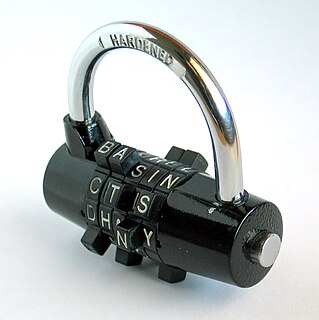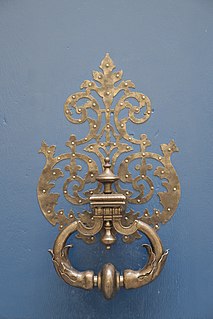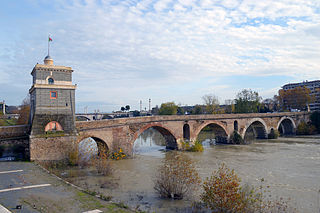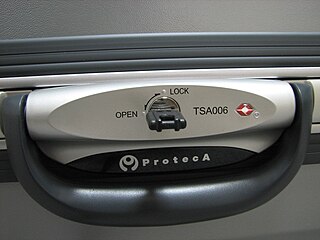Related Research Articles

Handcuffs are restraint devices designed to secure an individual's wrists in proximity to each other. They comprise two parts, linked together by a chain, a hinge, or rigid bar. Each cuff has a rotating arm which engages with a ratchet that prevents it from being opened once closed around a person's wrist. Without the key, the handcuffs cannot be removed without specialist knowledge, and the handcuffed person cannot move their wrists more than a few centimetres or inches apart, making many tasks difficult or impossible.

A mechanical puzzle is a puzzle presented as a set of mechanically interlinked pieces in which the solution is to manipulate the whole object or parts of it. One of the most well-known mechanical puzzles is the Rubik's Cube, invented by the Hungarian architect Ernő Rubik in 1974. The puzzles are mostly designed for a single player where the goal is for the player to see through the principle of the object, not so much that they accidentally come up with the right solution through trial and error. With this in mind, they are often used as an intelligence test or in problem solving training.

A warded lock is a type of lock that uses a set of obstructions, or wards, to prevent the lock from opening unless the correct key is inserted. The correct key has notches or slots corresponding to the obstructions in the lock, allowing it to rotate freely inside the lock.

Linus Yale Jr. was an American mechanical engineer, manufacturer, and co-founder of the Yale Lock Manufacturing Company. He is best known for his inventions of locks, especially the cylinder lock. His basic lock design is still widely distributed today, and constitutes a majority of personal locks and safes.

The pin tumbler lock is a lock mechanism that uses pins of varying lengths to prevent the lock from opening without the correct key. Pin tumblers are most commonly employed in cylinder locks, but may also be found in tubular pin tumbler locks.

A combination lock is a type of locking device in which a sequence of symbols, usually numbers, is used to open the lock. The sequence may be entered using a single rotating dial which interacts with several discs or cams, by using a set of several rotating discs with inscribed symbols which directly interact with the locking mechanism, or through an electronic or mechanical keypad. Types range from inexpensive three-digit luggage locks to high-security safes. Unlike ordinary padlocks, combination locks do not use keys.

A lock is a mechanical or electronic fastening device that is released by a physical object, by supplying secret information, or by a combination thereof or only being able to be opened from one side such as a door chain.

A dead bolt, deadbolt or dead lock is a locking mechanism distinct from a spring bolt lock because a deadbolt can be opened only by a key or handle. The more common spring bolt lock uses a spring to hold the bolt in place, allowing retraction by applying force to the bolt itself. A deadbolt can therefore make a door more resistant to entry without the correct key, as well as make the door more resistant to forced entry.

A bank vault is a secure space where money, valuables, records, and documents are stored. It is intended to protect their contents from theft, unauthorized use, fire, natural disasters, and other threats, much like a safe. Unlike safes, vaults are an integral part of the building within which they are built, using armored walls and a tightly fashioned door closed with a complex lock.

A door handle or doorknob is a handle used to open or close a door. Door handles can be found on all types of doors including exterior doors of residential and commercial buildings, internal doors, cupboard doors and vehicle doors. There are many designs of door handle, depending on the appropriate use. A large number of handles, particularly for commercial and residential doors, incorporate latching or locking mechanisms or are manufactured to fit to standardised door locking or latching mechanisms.

A bicycle lock is a security device used to deter bicycle theft, either by simply locking one of the wheels or by fastening the bicycle to a fixed object, e.g., a bike rack.

Jerry Slocum is an American historian, collector and author specializing on the field of mechanical puzzles. He worked as an engineer at Hughes Aircraft prior to retiring and dedicating his life to puzzles.

Padlocks are portable locks with a shackle that may be passed through an opening to prevent use, theft, vandalism or harm.

A latch or catch is a type of mechanical fastener that joins two objects or surfaces while allowing for their regular separation. A latch typically engages another piece of hardware on the other mounting surface. Depending upon the type and design of the latch, this engaged bit of hardware may be known as a keeper or strike.

The MilvianBridge is a bridge over the Tiber in northern Rome, Italy. It was an economically and strategically important bridge in the era of the Roman Empire and was the site of the famous Battle of the Milvian Bridge in 312, which led to the imperial rule of Constantine.

An electronic lock is a locking device which operates by means of electric current. Electric locks are sometimes stand-alone with an electronic control assembly mounted directly to the lock. Electric locks may be connected to an access control system, the advantages of which include: key control, where keys can be added and removed without re-keying the lock cylinder; fine access control, where time and place are factors; and transaction logging, where activity is recorded. Electronic locks can also be remotely monitored and controlled, both to lock and to unlock.

A luggage lock is a lock used to prevent luggage from opening by accident, usually with little or no security in mind, although the lock may serve as a deterrent to potential thieves. Luggage locks may be built into luggage or may be external locks such as padlocks or lockable straps.
Master Lock is an American company that develops padlocks, combination locks, safes, and related security products. Now a subsidiary of Fortune Brands Home & Security, Master Lock Company LLC was formed in 1921 by locksmith-inventor Harry E. Soref and is headquartered in Oak Creek, Wisconsin. In 1970 the company was purchased by American Brands from Soref's heirs. American Brands was later renamed to Fortune Brands, which then split on October 3, 2011, to create the Fortune Brands Home & Security company and the beverages company Beam Inc..

The John M. Mossman Lock Collection is housed at the General Society of Mechanics and Tradesmen of the City of New York building, located at 20 West 44th Street in midtown Manhattan, which is listed on the National Register of Historic Places. The museum houses one of the largest collections of bank and vault locks in the world, with more than 370 locks, keys and tools dating from 4000 BC to the modern 20th-century.

Nob Yoshigahara Puzzle Design Competition – is an annual award and competition in the engineering and design of mechanical puzzles. The location of the competition rotates between North America, Europe, and Japan. It was founded in 2001, and has been known since 2005 as the Nob Yoshigahara Puzzle Design Competition, after the renowned puzzler Nob Yoshigahara.
References
- 1 2 3 Hsiao, Kuo-Hung. "On the structural analysis of open-keyhole puzzle locks in ancient china".
- ↑ Slocum, Jerry. Romano-Celtic Mask Puzzle Padlocks: A Study in their Design, Technology and Security.
- ↑ Grundhauser, Eric. "The Fashion and Mystery of Ancient Roman Puzzle Locks". Atlas Obscura.
- ↑ Rhoda, Andrew. "The Jerry Slocum Mechanical Puzzle Collection at Indiana University". Indian State Library. Retrieved 15 November 2021.
- ↑ Minutes of Proceedings of the Institution of Civil Engineers. 1854.